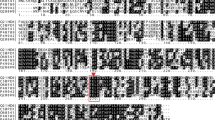Abstract
Two strains (Oα and X2) of the hyperthermophilic crenarchaeon Sulfolobus solfataricus strain MT4 were selected and isolated for their ability to grow on xylan. Oα and X2, grown on media containing oat spelt xylan and birchwood xylan as the sole nutrient source, respectively, produced the same thermostable xylanase that was demonstrated to be inducible in xylan cultures. In an oat spelt medium, S. solfataricus Oα underwent interesting morphological changes in the cell envelope, exhibiting mobile appendages not present in the typical coccal shape. The enzyme was prevalently membrane associated and showed a molecular mass of approximately 57.0 kDa. It was also highly thermostable, with a half-life of 47 min at 100°C, and exhibited an optimal temperature and pH of 90°C and 7.0, respectively. Xylo-oligosaccharides were the enzymatic products of xylan hydrolysis, and the smallest degradation product was xylobiose, thus indicating that the enzyme was an endoxylanase. The enzyme was able to bind weakly to crystalline cellulose (Avicel) and more strongly to insoluble xylan in a substrate amount-and temperature-dependent manner.




Similar content being viewed by others
References
Bedford MR (1995) Mechanism of action and potential environmental benefits from the use of feed enzymes. Anim Feed Sci Technol 53:145–155
Biely P (1985) Microbial xylanolytic systems. Trends Biotechnol 3:286–290
Biely P, Mislovicova D, Toman R (1985) Soluble chromogenic substrates for the assay of endo-1,4-beta-xylanases and endo-1,4-beta-glucanases. Anal Biochem 144:142–146
Black GW, Rixon JE, Clarke JH, Hazlewood GP, Ferreira LM, Bolan DN, Gilbert HJ (1997) Cellulose binding domains and linker sequences potentiate the activity of hemicellulases against complex substrates. J Biotechnol 57:59–69
Bradford MM (1976) A rapid and sensitive method for the quantification of microgram quantities of protein utilizing the principle of protein dye binding. Anal Biochem 72:248–254
Bragger JM, Daniel RM, Coolbear T, Morgan HW (1989) Very stable enzymes from extremely thermophilic archaebacteria and eubacteria. Appl Microbiol Biotechnol 31:556–561
Brock TD, Brock KM, Belly RT, Weiss RL (1972) Sulfolobus: a new genus of sulfur-oxidizing bacteria living at low pH and high temperature. Arch Microbiol 84:54–68
Carvalho Andrade CMM, Aguiar WB, Antranikian G (2001) Physiologic aspects involved in production of xylanolytic enzymes by a deep-sea hyperthermophilic archaeon Pyrodictium abyssi. Appl Biochem Biotechnol 91–93:1–15
Hayes C (2001) The effect of non-cariogenic sweeteners on the prevention of dental caries: a review of the evidence. J Dent Educ 65:1106–1109
Henrissat B, Coutinho PM (2001) Classification of glycoside hydrolases andglycosyltransferases from hyperthermophiles. Methods Enzymol 330:183–201
Hopkins MJ, Cummings JH, Macfarlane GT (1998) Inter-species differences in maximum specific growth rates and cell yields of Bifidobacteria cultured on oligosaccharides and other simple carbohydrate sources. J Appl Microbiol 85:381–386
Irwin D, Jung ED, Wilson DB (1994) Characterization and sequence of a Thermomonospora fusca xylanase. Appl Environ Microbiol 60:763–770
Laemmli UK (1970) Cleavage of structural proteins during the assembly of the head of bacteriophage T4. Nature 227:680–685
Maat J, Roza M, Verbakel J, Stam H, Santos de Silva MJ, Bosse M, Egmond MR, Hagemans MLD, van Gorcom RFM, Hessing JGM, van der Hondel CAMJJ, van Rotterdam C (1992) Xylanases and their application in bakery. In: Visser J (ed) Xylans and xylanases. Elsevier, Amsterdam, pp 349–360
Nelson N (1944) A photometric adaptation of the Somogyi method for the determination of glucose. J Biol Chem 153:375–380
Okazaki M, Fujikawa S, Matsumoto N (1990) Effects of xylo- oligosaccharides on growth of Bifidobacteria. J Jpn Soc Nutr Food Sci 43:395–401
Rolland JL, Gueguen Y, Flament D, Pouliquen Y, Street P, Dietrich J (2002) Comment on “The first description of an archaeal hemicellulase: the xylanase from Thermococcus zilligii strain AN1”: evidence that the unique N-terminal sequence proposed comes from a maltodextrin phosphorylase. Extremophiles 6:349–350
Sambrook J, Russell DW (2001) Molecular cloning. A laboratory manual. 3rd edn. Cold Spring Harbor Laboratory Press, Cold Spring Harbor, New York
Schwarz WH, Bronnenmeier K, Grabmitz F, Staudenbauer WL (1987) Activity staining of cellulases in polyacrylamide gels containing mixed linkage beta- glucans. Anal Biochem 164:72–77
She Q, Singh RH, Confalonieri F, Zivanovic Y, Allard G, Awayez MJ, Chan-Weiher CC, Clausen IG, Curtis BA, De Moors A, Erauso G, Fletcher C, Gordon PM, Heikamp-de Jong I, Jeffries AC, Kozera CJ, Medina N, Peng X, Thi-Ngoc HP, Redder P, Schenk ME, Theriault C, Tolstrup N, Charlebois RL, Doolittle WF, Duguet M, Gaasterland D, Garrett RA, Ragan MA, Sensen CW, Van der Oost J (2001) The complete genome of the crenarchaeon Sulfolobus solfataricus P2. Proc Natl Acad Sci USA 98:7835–7840
Simpson HD, Haufler UR, Daniel RM (1991) An extremely thermostable xylanase from the thermophilic eubacterium Thermotoga. Biochem J 15:413–417
Sunna A, Puls J, Antranikian G (1996) Purification and characterization of two thermostable endo-1,4-β-d-xylanases from Thermotoga thermarum. Biotechnol Appl Biochem 24:177–185
Taiz L, Zeiger E (1991) Plant and cell architecture. In: Taiz L, Zeiger E (eds) Plant physiology. Pearson Benjamin Cummings, Redwood City, Calif., pp 9–25
Thomson JA (1993) Molecular biology of xylan degradation. FEMS Microbiol Rev 104:65–82
Tsujibo H, Ohtsuki T, Ilo T, Yamazaki I, Miyamoto K, Sugiyama M, Inamori Y (1997) Cloning and sequence analysis of genes encoding xylanases and acetyl xylan esterase from Streptomyces thermoviolaceus OPC-520. Appl Environ Microbiol 63:661–664
Uhl AM, Daniel RM (1999) The first description of an archaeal hemicellulase: the xylanase from Thermococcus zilligii strain AN1. Extremophiles 3:263–267
Viikari L, Kantelinen A, Sundquist J, Linko M (1994) Xylanases in bleaching: from an idea to the industry. FEMS Microbiol Rev 13:335–350
Winterhalter C, Liebl W (1995) Two extremely thermostable xylanases of the hyperthermophilic bacterium Thermotoga maritima MSB8. Appl Environ Microbiol 61:1810–1815
Wong KKY, Saddler JN (1993) Application of hemicellulases in the food, feed, and pulp and paper industries. In: Coughlan MP, Hazlewood GP (eds) Hemicellulose and hemicellulases. Portland Press, London, pp 127–143
Author information
Authors and Affiliations
Corresponding author
Additional information
Communicated by G. Antranikian
Rights and permissions
About this article
Cite this article
Cannio, R., Di Prizito, N., Rossi, M. et al. A xylan-degrading strain of Sulfolobus solfataricus: isolation and characterization of the xylanase activity. Extremophiles 8, 117–124 (2004). https://doi.org/10.1007/s00792-003-0370-3
Received:
Accepted:
Published:
Issue Date:
DOI: https://doi.org/10.1007/s00792-003-0370-3




